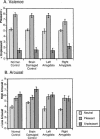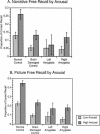Verbal and nonverbal emotional memory following unilateral amygdala damage
- PMID: 11773432
- PMCID: PMC311388
- DOI: 10.1101/lm.40101
Verbal and nonverbal emotional memory following unilateral amygdala damage
Abstract
The amygdala is involved in the normal facilitation of memory by emotion, but the separate contributions of the left and right amygdala to memory for verbal or nonverbal emotional material have not been investigated. Fourteen patients with damage to the medial temporal lobe including the amygdala (seven left, seven right), 18 brain-damaged, and 36 normal controls were exposed to emotional and neutral pictures accompanied by verbal narratives. Memory for both narratives and pictures was assessed with a free recall test 24 h later. Subjects with left amygdala damage failed to show the normally robust enhancement of memory for verbal and nonverbal emotional stimuli. The group with right amygdala damage showed the normal pattern of facilitation of memory by emotion for both verbal and nonverbal stimuli despite an overall reduction in memory performance. Furthermore, subjects with left amygdala damage were disproportionately impaired on memory for emotional narratives as compared with memory for emotional pictures. The latter finding offers partial support for a lateralized and material-specific pattern of the amygdala's contribution to emotional memory.
Figures



References
-
- Adolphs R, Cahill L, Schul R, Babinsky R. Impaired declarative memory for emotional material following bilateral amygdala damage in humans. Learn Mem. 1997;4:291–300. - PubMed
-
- Amaral DG, Price JL, Pitkanen A, Carmichael ST. Anatomical organization of the primate amygdaloid complex. In: Aggleton JP, editor. The amygdala: Neurobiological aspects of emotion, memory, and mental dysfunction. NY: Wiley-Liss; 1992. pp. 1–66.
-
- Barr WB. Examining the right temporal lobe's role in nonverbal memory. Brain Cogn. 1997;35:26–41. - PubMed
-
- Blair JR, Spreen O. Predicting premorbid IQ: A revision of the national adult reading test. Clin Neuropsychol. 1989;3:129–136.
Publication types
MeSH terms
Grants and funding
LinkOut - more resources
Full Text Sources
Medical
